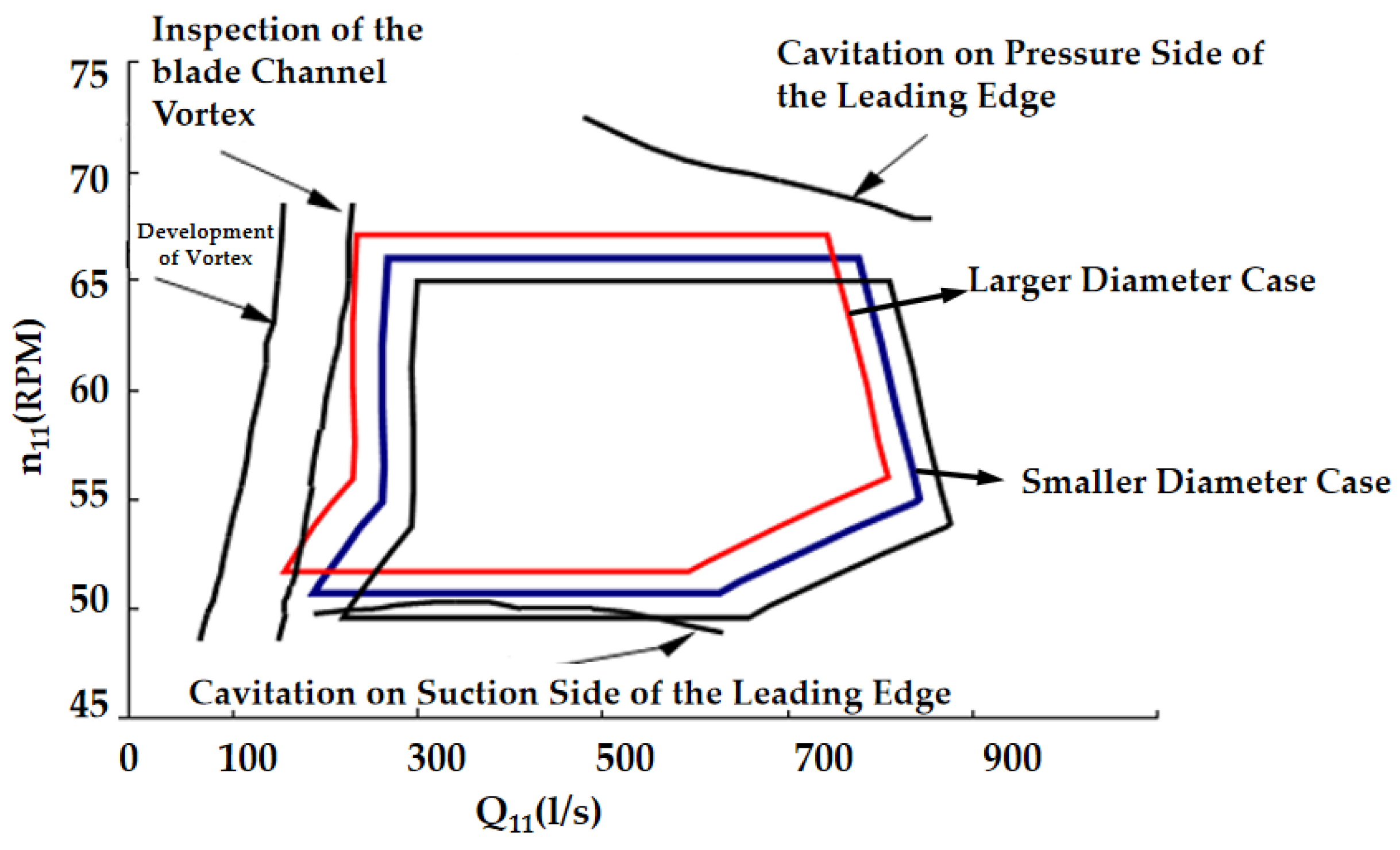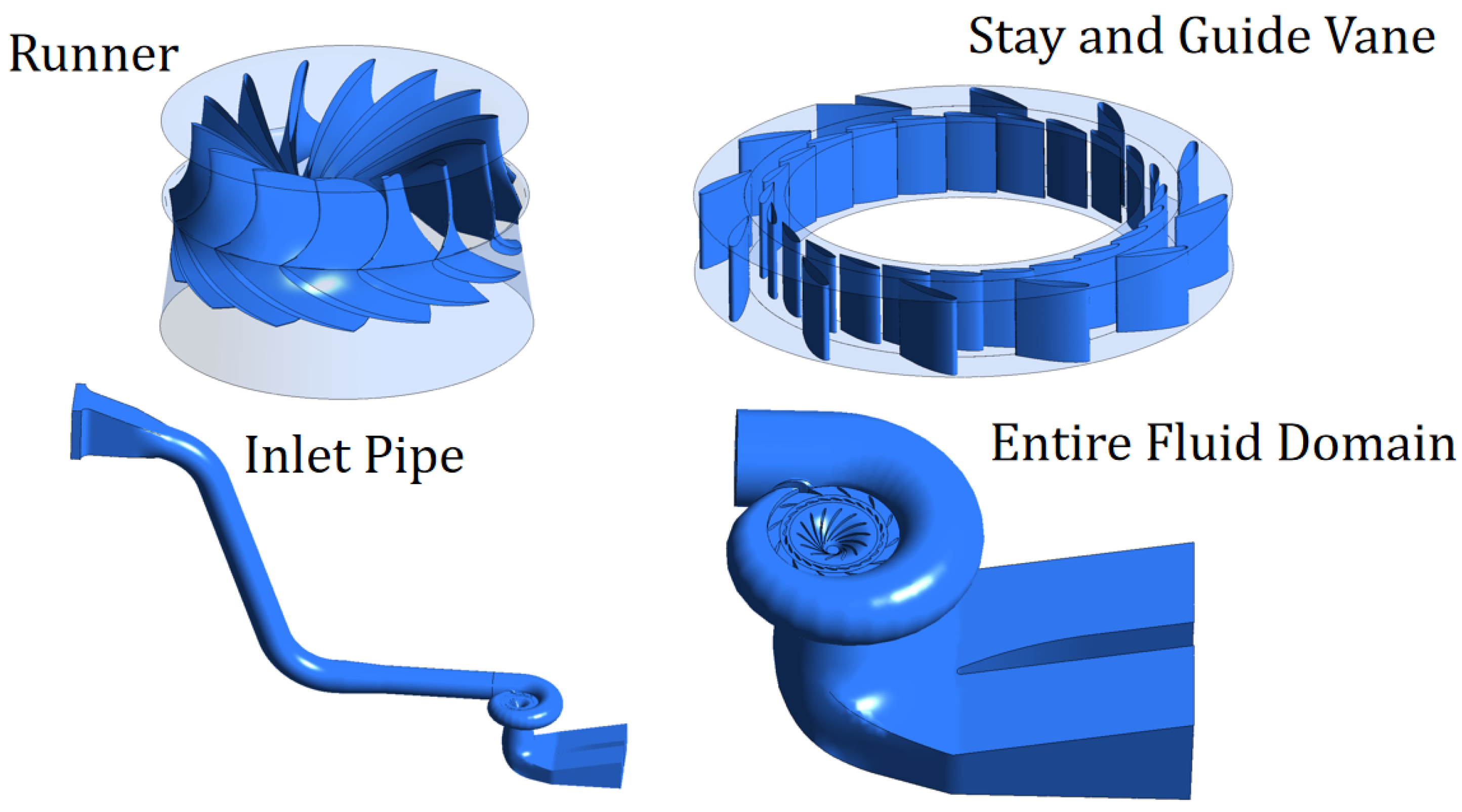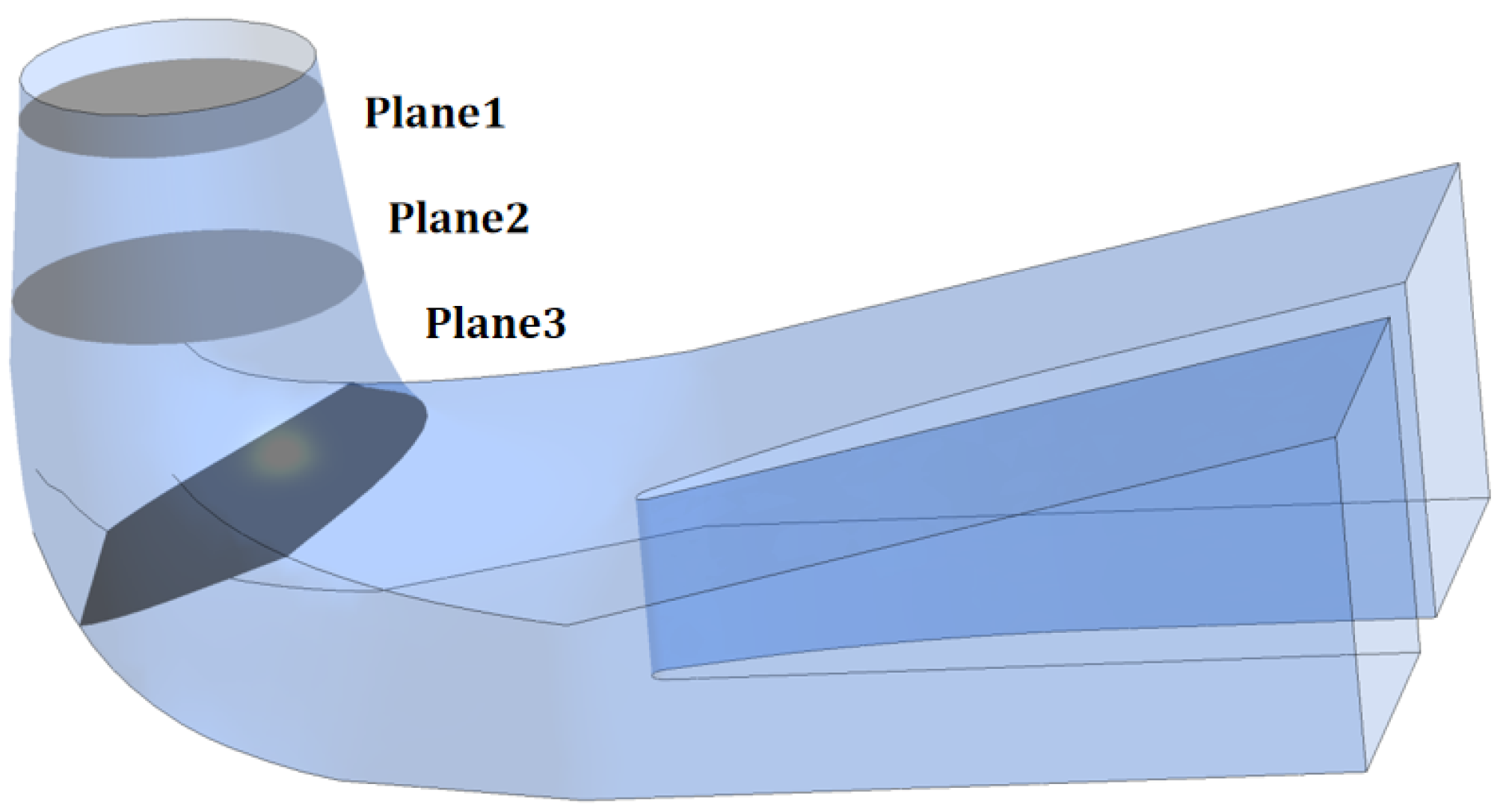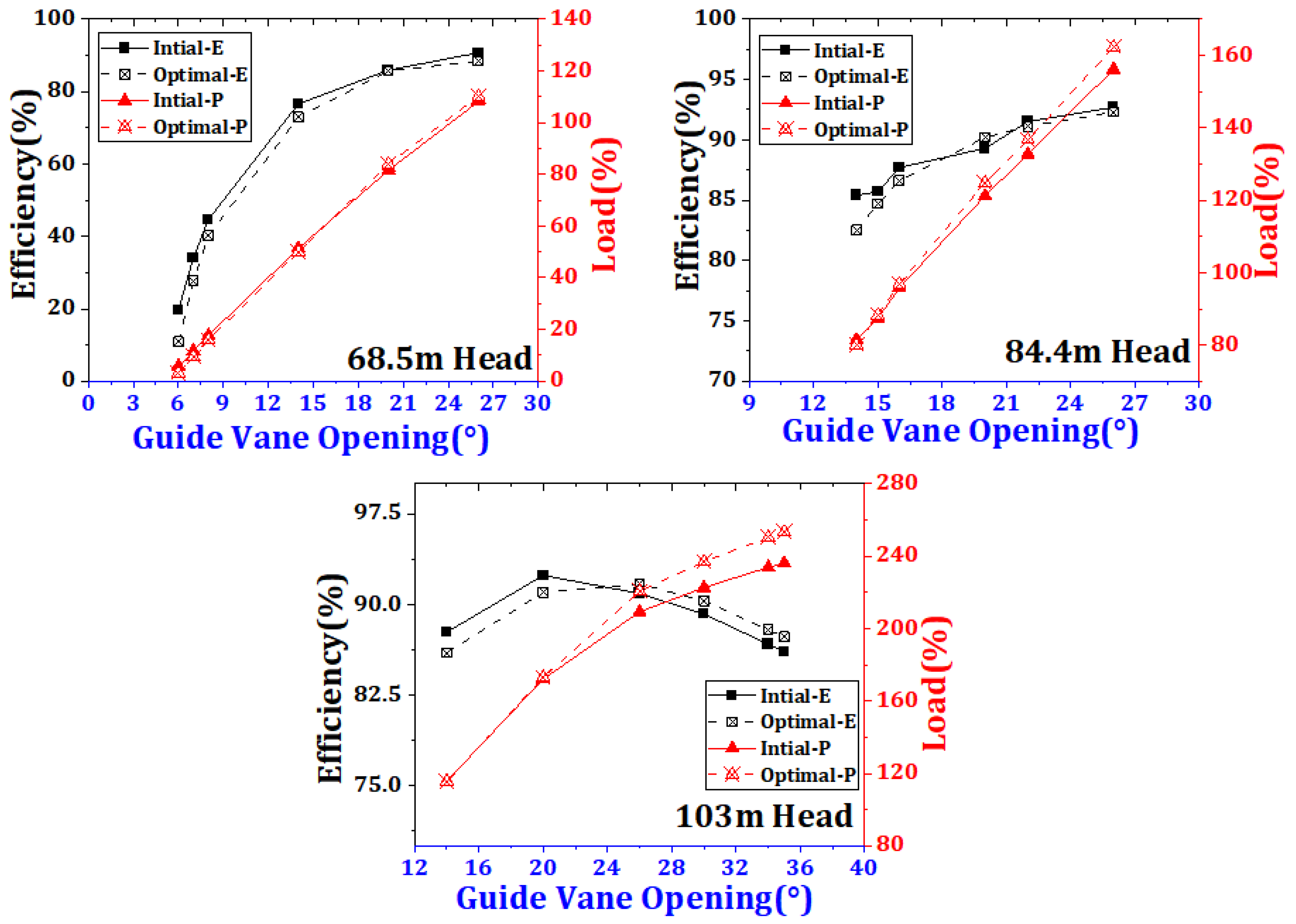Study on the Effect of a Splitter-Blade Runner on the Flexibility Improvement of Existing Francis Turbine Units
Abstract
1. Introduction
2. Engineering Requirements and Problem Analysis
2.1. Hydropower Station Background
2.2. Existing Operational Problems
- recurrent runner cracks, particularly near the leading edges of the blades;
- overall deterioration of hydraulic stability & efficiency.
2.3. Retrofit Objectives and Constraints
- expand the stable operating range from 50– to 0–;
- improve efficiency and existing blade geometry across the operating envelope.
3. Methodology
3.1. Geometric Modeling & Meshing
3.2. Governing Equations
3.3. Boundary Conditions and Numerical Setup
4. Results and Discussion
4.1. Performance Evaluation of the Original Runner
4.1.1. Efficiency and Power Assessment
4.1.2. Pressure Pulsations Assessment
4.2. Comparison Before and After Runner Optimization
4.2.1. Optimized Runner Model
4.2.2. Comparison of Efficiency and Power Before and After Optimization
4.2.3. Comparison of Pressure Pulsations Before and After Optimization
4.2.4. Comparison of Performance Before and After Optimization at Rated Operating Point
5. Conclusions
- The applicable head range of the splitter-blade runner has, for the first time, been successfully extended to below , while maintaining satisfactory hydraulic performance.
- Within the constraints of key runner dimensions (e.g., inlet and outlet diameters, inlet height, and overall runner height), the optimized splitter-blade runner outperforms the original runner in terms of efficiency and pressure pulsations. Its cavitation performance also meets the expected targets, providing a valuable reference for flexibility retrofits of existing Francis-type hydropower units.
- Compared with conventional runners, the splitter-blade runner exhibits superior structural rigidity and strength, making it more suitable for hydropower units that undergo frequent and wide-range load adjustments. This capability offers critical support for enhancing the operational flexibility of future power systems.
Author Contributions
Funding
Data Availability Statement
Conflicts of Interest
References
- Liu, Y.; Chen, L.; Han, X. The key problem analysis on the alternative new energy under the energy transition. Proc. CSEE 2022, 42, 515–523. (In Chinese) [Google Scholar] [CrossRef]
- Zhang, Z.; Kang, C. Challenges and prospects for constructing the new-type power system towards a carbon neutrality future. Proc. CSEE 2022, 42, 2806–2818. (In Chinese) [Google Scholar] [CrossRef]
- Liu, Y.; Ma, Q.; Wang, Z.; Li, P.; Liu, C. Cogitation on power and electricity balance dispatching in new power system. Proc. CSEE 2023, 43, 1694–1705. (In Chinese) [Google Scholar] [CrossRef]
- Lu, Z.; Lin, Y.; Qiao, Y.; Wu, L.; Xia, X. Flexibility supply-demand balance in power system with ultra-high proportion of renewable energy. Autom. Electr. Power Syst. 2022, 46, 3–16. (In Chinese) [Google Scholar]
- Trivedi, C.; Iliev, I.; Dahlhaug, O.G.; Markov, Z.; Engstrom, F.; Lysaker, H. Investigation of a Francis turbine during speed variation: Inception of cavitation. Renew. Energy 2020, 166, 147–162. [Google Scholar] [CrossRef]
- Narayanan, A.; Mets, K.; Strobbe, M.; Develder, C. Feasibility of 100% renewable energy-based electricity production for cities with storage and flexibility. Renew. Energy 2019, 134, 698–709. [Google Scholar] [CrossRef]
- Cheng, C. Function remolding of hydropower systems for carbon neutral and its key problems. Autom. Electr. Power Syst. 2021, 45, 29–36. (In Chinese) [Google Scholar] [CrossRef]
- Zhou, J.; Du, X.; Zhou, X. Study on hydropower development strategy for new power systems. J. Hydroelectr. Eng. 2022, 41, 106–115. (In Chinese) [Google Scholar]
- Ren, R.; Du, Q.; Liu, G.; Lian, Z.; Xie, L.; Luo, Y. Numerical Simulation and Experimental Study of the Rotor–Stator Interaction of a Turbine Under Variable Flow Coefficients. J. Mar. Sci. Appl. 2025, 24, 518–531. [Google Scholar] [CrossRef]
- Wang, Y.; Levin, T.; Kwon, J.; Baker, E. The value of hydropower flexibility for electricity system decarbonization. Energy Rep. 2025, 13, 2711–2721. [Google Scholar] [CrossRef]
- Sato, K.; Tamura, Y.; Tani, K. Multi-objective optimization for francis turbine runner using genetic algorithm. In Proceedings of the ASME International Mechanical Engineering Congress and Exposition, Montreal, QC, Canada, 14–20 November 2014. [Google Scholar] [CrossRef]
- Liang, H. Analysis of Uplift deformation of hydroelectric generating units in Jiangya hydropower station. Hunan Hydro Power 2013, 58, 69–70. (In Chinese) [Google Scholar]
- Cai, Y.; Li, D.; Yan, F. Analysis and Discussion on the Vibration of Turbine-Generator Sets in Gongzui Hydropower Station. Water Power 2014, 12. (In Chinese) [Google Scholar]
- GB/T 15468-2018; Fundamental Technical Requirements for Hydraulic Turbines. Standardization Administration of China: Beijing, China, 2018.
- Shang, X.X.; Lu, N. Study on Vibration Characteristics under Low Water Head of Large Scale Francis Turbine. Water Resour. Power 2019, 1. (In Chinese) [Google Scholar]
- Liu, X.; Luo, Y.; Wang, Z. A review on fatigue damage mechanism in hydro turbines. Renew. Sustain. Energy Rev. 2016, 54, 1–14. [Google Scholar] [CrossRef]
- Wang, X.; Zhao, Y.; Wang, H.; Huang, X. Effect of turbine vibration on unit efficiency of Ahai hydropower station. Water Resour. Power 2022, 40, 156–160. (In Chinese) [Google Scholar] [CrossRef]
- Liao, M.; Gong, X.; Yang, B.; Li, G.; Cao, D. A Review of Stress Research on Large Mixed-Flow Turbine Runners. Hydropower Stn. Electromech. Technol. 2024, 47, 13–16+115. [Google Scholar] [CrossRef]
- Chen, Y.; Wang, H.; Si, X.; He, J. Hydraulic Vibration Analysis of Dongqing Hydropower Station Under Off-Design Operating Conditions. Hydropower Stn. Electromech. Technol. 2022, 45, 20–22+35+141. [Google Scholar] [CrossRef]
- Yang, Y. Analysis of cracks on the runner blades of Ludila hydropower station. Yunnan Water Power 2023, 39, 257–260. (In Chinese) [Google Scholar] [CrossRef]
- Wang, Y.; Zhu, Q.; Li, J.; Yuan, S.; Liu, X. Numerical simulation of the internal flow field of Francis turbine runner with long and short blades. China Rural. Water Hydropower 2020, 24, 179–185. (In Chinese) [Google Scholar]
- Song, X.; Mao, X.; Lu, J.; Zhang, X. Optimization Design of a Mixed-Length Blade Pump-Turbine Runner Based on CFD. Water Resour. Hydropower Eng. 2021, 52, 115–123. [Google Scholar] [CrossRef]
- Fan, Y.; He, Q.; Wang, M.; Xie, S. Application and study on vibration improvement by runner with splitter blades. Water Resour. Hydropower Eng. 2022, 53, 58–68. (In Chinese) [Google Scholar] [CrossRef]
- Guan, Z.; He, S.; Liang, Q.; Kang, W.; Zhang, J.; Zeng, J.; Wang, Z.; He, Q. Numerical study of hydraulic excitation modes caused by rotor-stator interaction of a runner with splitters. Hydropower Pumped Storage 2024, 1, 7–11+37. (In Chinese) [Google Scholar] [CrossRef]
- Zhang, M.; Valentin, D.; Valero, C.; Egusquiza, M.; Zhao, W. Numerical study on the dynamic behavior of a Francis turbine runner model with a crack. Energies 2018, 11, 1630. [Google Scholar] [CrossRef]
- Bosioc, A.I.; Susan-Resiga, R.; Muntean, S.; Tanasa, C. Unsteady Pressure Analysis of a Swirling Flow with Vortex Rope and Axial Water Injection in a Discharge Cone. J. Fluids Eng. 2012, 134, 081104. [Google Scholar] [CrossRef]
- Koukouvinis, P.; Gavaises, M.; Supponen, O.; Farhat, M. Simulation of bubble expansion and collapse in the vicinity of a free surface. Phys. Fluids 2016, 28, 052103. [Google Scholar] [CrossRef]
- Ma, Z.; Zhu, B.; Rao, C.; Shangguan, Y. Comprehensive Hydraulic Improvement and Parametric Analysis of a Francis Turbine Runner. Energies 2019, 12, 307. [Google Scholar] [CrossRef]
- Yang, J.; Wang, X.; Pei, J.-X.; Yan, Y.; Wang, W.-Q. A new strategy for reducing pressure fluctuation of Francis turbine by bionic modification of local components. Sustain. Energy Technol. Assess. 2024, 71, 104014. [Google Scholar] [CrossRef]
- Nicolet, C.; Arpe, J.; Avellan, F. Identification and modeling of pressure fluctuations of a Francis turbine scale model at part load operation. In Proceedings of the 22nd IAHR Symposium on Hydraulic Machinery and Systems, Stockholm, Sweden, 29 June–2 July 2004. [Google Scholar]
- Favrel, A.; Müller, A.; Landry, C.; Yamamoto, K.; Avellan, F. Study of the vortex-induced pressure excitation source in a Francis turbine draft tube by particle image velocimetry. Exp. Fluids 2015, 56, 215. [Google Scholar] [CrossRef]
- Tang, L.; Yuan, S.; Tang, Y.; Gao, Z. Performance Characteristics in Runner of an Impulse Water Turbine with Splitter Blade. Processes 2021, 9, 303. [Google Scholar] [CrossRef]
- Jia, Y.; Wei, X.; Wang, Q.; Cui, J.; Li, F. Experimental Study of the Effect of Splitter Blades on the Performance Characteristics of Francis Turbines. Energies 2019, 12, 1676. [Google Scholar] [CrossRef]
- Chen, J.; Zheng, Y.; Zhang, L.; He, G.; Zou, Y.; Xiao, Z. Optimization of geometric parameters of hydraulic turbine runner in turbine mode based on the orthogonal test method and CFD. Energy Rep. 2022, 8, 14476–14487. [Google Scholar] [CrossRef]
- Mirza Umar, B.; Huang, X.; Wang, Z. Experimental Flow Performance Investigation of Francis Turbines from Model to Prototype. Appl. Sci. 2024, 14, 7461. [Google Scholar] [CrossRef]
- Zhang, J.; Cheng, C.; Yu, S.; Shen, J.; Wu, X.; Su, H. Preliminary feasibility analysis for remaking the function of cascade hydropower stations to enhance hydropower flexibility: A case study in China. Energy 2022, 260, 125163. [Google Scholar] [CrossRef]












| Name | Parameter |
|---|---|
| Maximum head (m) | 103 |
| Weighted average head (m) | 90.4 |
| Rated head (m) | 84.4 |
| Minimum head (m) | 68.5 |
| Turbine | Generator | ||
|---|---|---|---|
| Name | Parameter | Name | Parameter |
| Version | HLD89-LJ-500 | Version | SF175-44/10350 |
| Rated power (MW) | 178.6 | Rated capacity (MVA) | 200 |
| Rated speed (r/min) | 136.4 | Rated voltage (kV) | 13.8 |
| Rated discharge (m3/s) | 239 | Rated current (A) | 8367 |
| Runaway speed (r/min) | 271.4 | Rated excitation voltage (V) | 385 |
| Number of adjustable guide vanes | 24 | Rated excitation current (A) | 1430 |
| Number of rotor blades | 14 | Type of generator | Half-sleeved |
| Operating Condition | Waterhead (m) | Guide Vane Opening (°) | Operating Condition | Waterhead (m) | Guide Vane Opening (°) |
|---|---|---|---|---|---|
| 1 | 68.5 | 6 | 15 | 84.4 | 30 |
| 2 | 68.5 | 7 | 16 | 84.4 | 32 |
| 3 | 68.5 | 8 | 17 | 84.4 | 34 |
| 4 | 68.5 | 14 | 18 | 84.4 | 39 |
| 5 | 68.5 | 20 | 19 | 84.4 | 40.5 |
| 6 | 68.5 | 26 | 20 | 84.4 | 42.5 |
| 7 | 84.4 | 4 | 21 | 103 | 4 |
| 8 | 84.4 | 14 | 22 | 103 | 14 |
| 9 | 84.4 | 15 | 23 | 103 | 20 |
| 10 | 84.4 | 16 | 24 | 103 | 26 |
| 11 | 84.4 | 20 | 25 | 103 | 30 |
| 12 | 84.4 | 22 | 26 | 103 | 34 |
| 13 | 84.4 | 26 | 27 | 103 | 35 |
| 14 | 84.4 | 28 |
| Guide Vane Opening (°) | 6 | 7 | 8 | 14 | 20 | 26 |
|---|---|---|---|---|---|---|
| Efficiency–CFD (%) | 21.00 | 32.50 | 43.40 | 72.50 | 87.50 | 90.80 |
| Efficiency–TEST (%) | 19.70 | 34.10 | 44.70 | 76.60 | 85.90 | 90.70 |
| Load–CFD (%) | 3.51 | 6.13 | 10.00 | 26.05 | 48.43 | 63.01 |
| Load–TEST (%) | 3.24 | 6.56 | 9.90 | 28.78 | 45.65 | 60.56 |
| Guide Vane Opening (°) | 14 | 15 | 16 | 20 | 22 | 26 |
|---|---|---|---|---|---|---|
| Efficiency–CFD (%) | 82.10 | 85.30 | 88.20 | 91.00 | 91.80 | 93.60 |
| Efficiency–TEST (%) | 85.40 | 85.70 | 87.70 | 89.30 | 91.50 | 92.70 |
| Load–CFD (%) | 45.00 | 50.10 | 54.10 | 68.70 | 76.00 | 89.00 |
| Load–TEST (%) | 45.60 | 48.92 | 53.62 | 67.84 | 74.31 | 87.41 |
| Guide Vane Opening (°) | 14 | 20 | 26 | 30 | 34 | 35 |
|---|---|---|---|---|---|---|
| Efficiency–CFD (%) | 84.30 | 91.90 | 93.40 | 92.10 | 90.00 | 89.00 |
| Efficiency–TEST (%) | 87.10 | 90.50 | 92.60 | 90.00 | 87.40 | 86.80 |
| Load–CFD (%) | 52.50 | 77.60 | 98.00 | 105.00 | 110.00 | 115.00 |
| Load–TEST (%) | 52.43 | 76.70 | 96.84 | 102.97 | 107.89 | 108.95 |
| The Supervisory | Operating Mode | |||
|---|---|---|---|---|
| 6% | 50% | 110% | ||
| Plane 1 | 6.21% | 10.28% | 8.94% | |
| 4.93% | 5.96% | 8.21% | ||
| Plane 2 | 4.88% | 9.30% | 6.96% | |
| 3.94% | 4.46% | 6.49% | ||
| Plane 3 | 5.27% | 5.87% | 5.59% | |
| 2.97% | 3.58% | 4.60% | ||
| Guide Vane Opening (°) | Initial–E (%) | Optimal–E (%) | Initial–P (MW) | Optimal–P (MW) |
|---|---|---|---|---|
| 6 | 19.7 | 10.9 | 5.78 | 3.15 |
| 7 | 34.1 | 27.7 | 11.72 | 9.47 |
| 8 | 44.7 | 40.2 | 17.69 | 15.98 |
| 14 | 76.6 | 72.9 | 51.41 | 50.02 |
| 20 | 85.9 | 85.7 | 81.54 | 83.96 |
| 26 | 90.7 | 88.4 | 108.16 | 110.15 |
| Guide Vane Opening (°) | Initial–E (%) | Optimal–E (%) | Initial–P (MW) | Optimal–P (MW) |
|---|---|---|---|---|
| 14 | 85.4 | 82.5 | 81.45 | 80.04 |
| 15 | 85.7 | 84.7 | 87.37 | 88.26 |
| 16 | 87.7 | 86.6 | 95.76 | 96.88 |
| 20 | 89.3 | 90.2 | 121.16 | 124.76 |
| 22 | 91.5 | 91.1 | 132.72 | 136.68 |
| 26 | 92.7 | 92.3 | 156.11 | 162.29 |
| Guide Vane Opening (°) | Initial–E (%) | Optimal–E (%) | Initial–P (MW) | Optimal–P (MW) |
|---|---|---|---|---|
| 14 | 87.7 | 86.0 | 115.82 | 115.47 |
| 20 | 92.4 | 91.0 | 172.03 | 173.16 |
| 26 | 90.9 | 91.7 | 209.31 | 220.58 |
| 30 | 89.2 | 90.3 | 222.74 | 236.98 |
| 34 | 86.7 | 87.9 | 233.82 | 250.40 |
| 35 | 86.1 | 87.3 | 236.24 | 253.36 |
| The Supervisory Plane | Hr, 1% Load | Hmax, 6% Load | |
|---|---|---|---|
| Plane 1 | 4.97% | 4.09% | |
| 4.02% | 3.33% | ||
| Plane 2 | 4.92% | 4.34% | |
| 3.31% | 2.77% | ||
| Plane 3 | 5.57% | 5.04% | |
| 2.56% | 2.13% |
| The Supervisory Plane | Hr, 1% Load | Hmax, 6% Load | |
|---|---|---|---|
| Plane 1 | 2.52% | 1.94% | |
| 1.42% | 1.15% | ||
| Plane 2 | 2.96% | 2.53% | |
| 1.22% | 0.99% | ||
| Plane 3 | 4.20% | 3.83% | |
| 0.92% | 0.73% |
Disclaimer/Publisher’s Note: The statements, opinions and data contained in all publications are solely those of the individual author(s) and contributor(s) and not of MDPI and/or the editor(s). MDPI and/or the editor(s) disclaim responsibility for any injury to people or property resulting from any ideas, methods, instructions or products referred to in the content. |
© 2025 by the authors. Licensee MDPI, Basel, Switzerland. This article is an open access article distributed under the terms and conditions of the Creative Commons Attribution (CC BY) license (https://creativecommons.org/licenses/by/4.0/).
Share and Cite
Lu, C.; Zhang, H.; Wang, Z.; Lv, Y.; Mirza Umar, B. Study on the Effect of a Splitter-Blade Runner on the Flexibility Improvement of Existing Francis Turbine Units. Energies 2025, 18, 5978. https://doi.org/10.3390/en18225978
Lu C, Zhang H, Wang Z, Lv Y, Mirza Umar B. Study on the Effect of a Splitter-Blade Runner on the Flexibility Improvement of Existing Francis Turbine Units. Energies. 2025; 18(22):5978. https://doi.org/10.3390/en18225978
Chicago/Turabian StyleLu, Chi, Heng Zhang, Zhengwei Wang, Yijing Lv, and Baig Mirza Umar. 2025. "Study on the Effect of a Splitter-Blade Runner on the Flexibility Improvement of Existing Francis Turbine Units" Energies 18, no. 22: 5978. https://doi.org/10.3390/en18225978
APA StyleLu, C., Zhang, H., Wang, Z., Lv, Y., & Mirza Umar, B. (2025). Study on the Effect of a Splitter-Blade Runner on the Flexibility Improvement of Existing Francis Turbine Units. Energies, 18(22), 5978. https://doi.org/10.3390/en18225978









